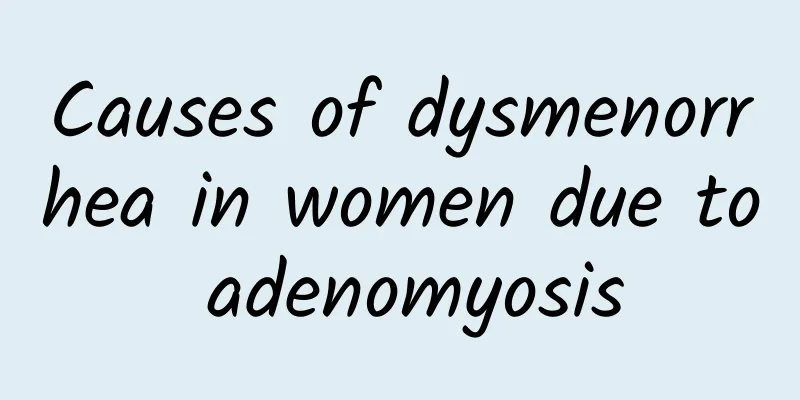Causes of dysmenorrhea in women due to adenomyosis

|
As we all know, dysmenorrhea is one of the common symptoms of women's menstrual period. The pain that goes deep into the bone marrow must be deeply understood by every woman who has experienced dysmenorrhea. It is understood that dysmenorrhea can also be divided into primary and secondary types. Methods/Steps Among them, primary dysmenorrhea refers to the dysmenorrhea that occurs with the first menstruation during the female development period. This phenomenon tends to gradually improve as the female sexual development gradually matures. Secondary dysmenorrhea refers to the dysmenorrhea that occurs after the female reproductive system has lesions. Because the pain is generally deep and has a great impact on women's daily life, it has become the "most unbearable" pain in women's lives. Female dysmenorrhea caused by adenomyosis is one of the representatives! One of the main causes of adenomyosis is damage to the uterine wall caused by multiple pregnancies and childbirths in women. Since there is no submucosal layer between the basal layer and the myometrium of the endometrium, under normal circumstances, the basal layer endometrium does not invade the myometrium downward. When the endometrium invades the myometrium, it will lead to the occurrence of adenomyosis. The treatment recommended is to take Fuyan Pills. Because the ectopic endometrium grows diffusely or locally in the myometrium, it stimulates the proliferation of the surrounding smooth muscle and fibrous connective tissue, interfering with the normal contraction of the uterus. Especially before or during menstruation, congestion, edema or bleeding causes the uterus to be larger than usual. Due to the stimulation of increased local pressure, the surrounding muscles undergo spasmodic contraction and cause dysmenorrhea. Causes of dysmenorrhea in women due to adenomyosis Patients with adenomyosis also have uterine hypoplasia, which causes abnormal blood supply, leading to uterine ischemia and hypoxia, causing dysmenorrhea. The narrowing of the cervical canal caused by adenomyosis hinders the outflow of menstruation, thus causing dysmenorrhea. The content of prostaglandins in menstrual blood and endometrium increases, causing the uterine muscle fibers to contract and causing dysmenorrhea. Dysmenorrhea is caused by excessive contraction of the uterus. As the uterus contracts violently, the uterus cannot completely relax for a long period of time, thus causing dysmenorrhea. Precautions Dysmenorrhea is a serious symptom of adenomyosis in women, which is very harmful to modern women. From the perspective of traditional Chinese medicine, adenomyosis belongs to the category of symptom. With the acceleration of the pace of modern life, adenomyosis is showing a trend of younger people, and many young unmarried women have also become victims of this disease. If you want to treat the root cause, you should treat it from the perspective of clearing away heat and detoxification, and promoting blood circulation and removing blood stasis. |
<<: Can irregular menstruation cause leg pain?
>>: Do you know about the related issues of vaginitis infection?
Recommend
Will drinking water make you fat? Three groups of people with heart disease, liver and kidney dysfunction should be restricted
Drinking more water has many benefits, but many p...
It’s easy to lose belly fat, just use these 3 exercises to show off your belly easily! Fitness coach: 4 big mistakes you should avoid making
As the weather continues to be hot, more people a...
How to save bleeding after abortion
Bleeding during intercourse after abortion may be...
How to treat female adnexitis?
Adnexitis is a common disease caused by pathogeni...
Introduction to the three main types of people who are susceptible to uterine fibroids
In real life, every female friend may suffer from...
Treatment of abnormal leucorrhea in gynecology
An abnormal increase in gynecological vaginal dis...
Is it normal for the right ovarian cyst to cause less and darker menstrual flow? What are the dangers?
Is it normal for the right ovarian cyst to cause ...
Be the first to recognize the common symptoms of chronic adnexitis
Adnexitis is a major obstacle to women's heal...
How to relieve back pain during menstruation 6 tips to relieve back pain during menstruation
Women normally have their periods every month, bu...
How do women determine whether they are in menopause? 3 major symptoms and data clearly tell you
How can women judge whether they are in menopause...
Postoperative care for adnexitis is crucial
Surgery is one of the methods to treat adnexitis....
How much does the abortion process cost?
The cost of abortion varies by region, hospital g...
Will cervical erosion after pregnancy cause leucorrhea to turn brown?
Whether before or during pregnancy, you may find ...
Getting up early and doing 12 yoga moves can help your metabolism and lose weight quickly
Morning exercise is a habit of many people. The a...
Body Sculpting Tutorial - Three Must-Learn Tips to Reduce Belly Fat (Part 2)
Regardless of gender, age or status, the lower ab...









